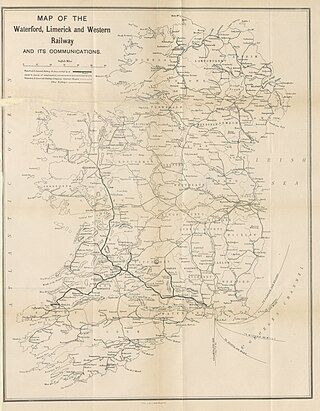Top Qs
Timeline
Chat
Perspective
Waterford, Limerick and Western Railway
Former railway company in Ireland From Wikipedia, the free encyclopedia
Remove ads
The Waterford, Limerick and Western Railway (WL&WR), formerly the Waterford and Limerick Railway (W&LR) up to 1896,[2] was at the time it was amalgamated with the Great Southern and Western Railway in 1901 the fourth largest railway in Ireland, with a main line stretching from Limerick to Waterford and branches to Sligo and Tralee.
Remove ads
Inception
The Limerick and Waterford Railway Act 1826 (7 Geo. 4. c. cxxxix) was passed by the Parliament of the United Kingdom on 31 May 1826 and had the distinction of being the first act authorising an Irish railway.[3] No construction followed and it was 1845 before the Waterford and Limerick Railway was authorised by the Waterford and Limerick Railway Act 1845 (8 & 9 Vict. c. cxxxi), the first section of the line being opened from Limerick to Tipperary on 9 May 1848, the remainder of the main line being opened in stages, finally reaching Waterford in 1854.[4]
Remove ads
Secondary lines
The company eventually operated two long branch lines which extended from Limerick, north west to Sligo and south west to Tralee.
Branch lines
Summarize
Perspective
By 1900, there were a number of branch lines:
- Ballingrane to Foynes, (opened by the Limerick and Foynes Railway 1858, purchased by the W&LR 1873)
- Killonan to Killaloe, (opened by the Limerick, Castleconnell and Killaloe Railway between 1858 and 1867, purchased by the W&LR 1873)
- Clonmel to Thurles, (opened by the Southern of Ireland Railway 1880)
- Tralee to Fenit, an 8 miles (13 km) section opened in 1887[5] by the Tralee and Fenit Railway.
Under the Waterford and Limerick Railway Act 1873 (36 & 37 Vict. c. clxxviii) the W&LR took over the Limerick and Foynes Railway, the Rathkeale and Newcastle Junction Railway, the Limerick and Ennis Railway, the Athenry and Ennis Junction Railway, and the Athenry and Tuam Railway.
Remove ads
People
The W&LR was generally short of cash to maintain rolling stock and most locomotive superintendents who were typically did not stay long.[6] Incumbents included:
- Thomas Lunt, who came from the Liverpool and Manchester Railway and was in position from 1853 to 1857.[6]
- Jonathan Pim, son for James Pim, locomotive superintendent from 1857 to 1861.[7]
- Martin Atock was locomotive superintendent from 1861 until 1871.[8]
- John G. Robinson was locomotive, carriage and wagon assistant superintendent of the railway from 1889 till 1900 when he moved to a similar position with the Great Central Railway.
Remove ads
Amalgamation

(thick black lines)
On 6 August 1900, the Great Southern and Western, and Waterford, Limerick and Western Railways Amalgamation Act 1900 (63 & 64 Vict. c. ccxlvii) was passed by the House of Commons and the WL&WR finally lost its independence on 1 January 1901.
Remove ads
Livery
The WL&WR locomotives were painted a medium green until 1876 and was replaced by a brown livery with blue and yellow lining. In the late 1880s, J.G. Robinson introduced a crimson lake livery with gold lining for both passenger locomotives and coaching stock, very close to that of the Midland Railway of England. Goods engines were painted black with red and white lining.
Remove ads
Present day
The former WL&WR lines operational in 2010 are owned by Iarnród Éireann. The main line route from Limerick to Waterford and the line to Ennis remain open to passenger traffic. The extension of the line from Ennis to Athenry (for Galway) was officially re-opened on 29 March 2010. These lines are part of the Western Railway Corridor.
Remove ads
See also
References
Sources
Further reading
External links
Wikiwand - on
Seamless Wikipedia browsing. On steroids.
Remove ads



